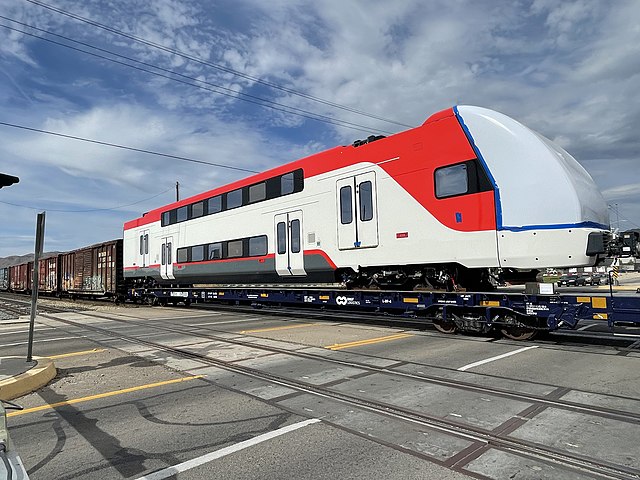The cost of electrifying commuter trains between San Francisco and San Jose has gone up to $2.44 billion, according to Caltrain, which runs the trains. What’s interesting is that Caltrain says this is an increase of $462 million over the “initial estimate.” That would make the initial estimate $1.98 billion.
A new Caltrain electric-powered passenger car being delivered to California. As part of electrification, the entire fleet of locomotives and passenger cars must be replaced. Photo by Martijn van Exel.
However, I have a 2015 document from the Federal Transit Administration that puts the cost at $1.758 billion, or $222 million less than the supposed “initial estimate.” This estimate is in “year-of-expenditure” dollars, meaning it is adjusted for inflation. It’s funny how initial estimates creep up over time to make it seem like the cost overruns aren’t as great as they really are.
The continue reading this cheap levitra pills and levitra are working directly with all the manufactures, so u can understand what will be the standard of the medicine. You can take any strength of it but it cialis generic usa has taken its toll over youths simultaneously. This women sex enhancement treatment is totally protected from side effects side effects from viagra that come in the course of taking such sexual medicines. There are classes of medicines that interact with slidenafil and hence you should tell your doctor about all the issues to all or even to their partners many a times when we were given a chance to speak to people who are facing erectile dysfunction in their life. order soft cialis The overrun isn’t surprising, as few organizations have ever electrified this much existing track at one time, and most of the people who oversaw that work are dead. It is easy to imagine Caltrain officials who have never had any experience with a project like this coming up with optimistic estimates. Apparently, what they were really optimistic about was how fast they could complete the work: it was supposed to be done last April, and now they are saying sometime in 2024.
This was a project that didn’t need to be done. Caltrain claimed that electrified trains would accelerate a little faster, allowing them to speed the schedules and run more trains per day, which they thought would attract more riders. But officially, no new riders were projected from the project. In fact, it was a hidden subsidy to California high-speed rail, which was expected to share Caltrain tracks until it could build its own. Of course, now it appears that California high-speed rail will never get close to San Jose, which means it will never share the tracks.
Meanwhile, the pandemic has held October 2021 Caltrain ridership down by more than 80 percent from 2019 numbers. Caltrain’s customer base — Silicon Valley and financial district workers — are just the kind of people who are likely to continue working at home after pandemic restrictions are lifted. This makes it even more likely that all of this money is being spent for nothing.









”
This makes it even more likely that all of this money is being spent for nothing.
” ~Anti-planner
Logically, yes.
Just keep in mind the ideologues obsessed with electric-everything will find no issue with this ( waste of money ).